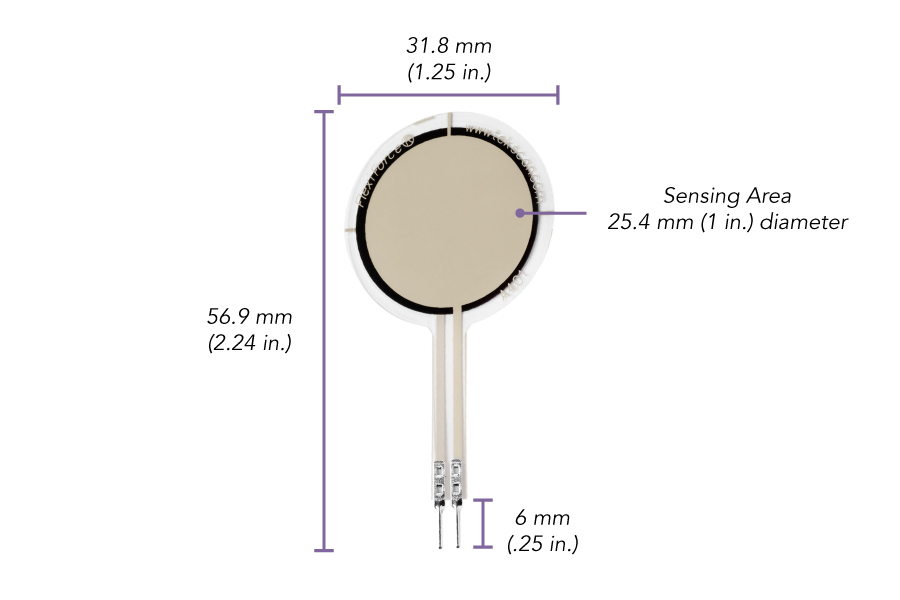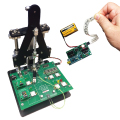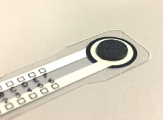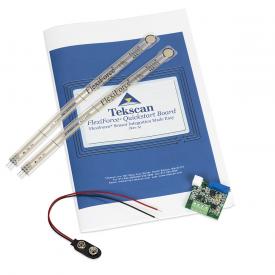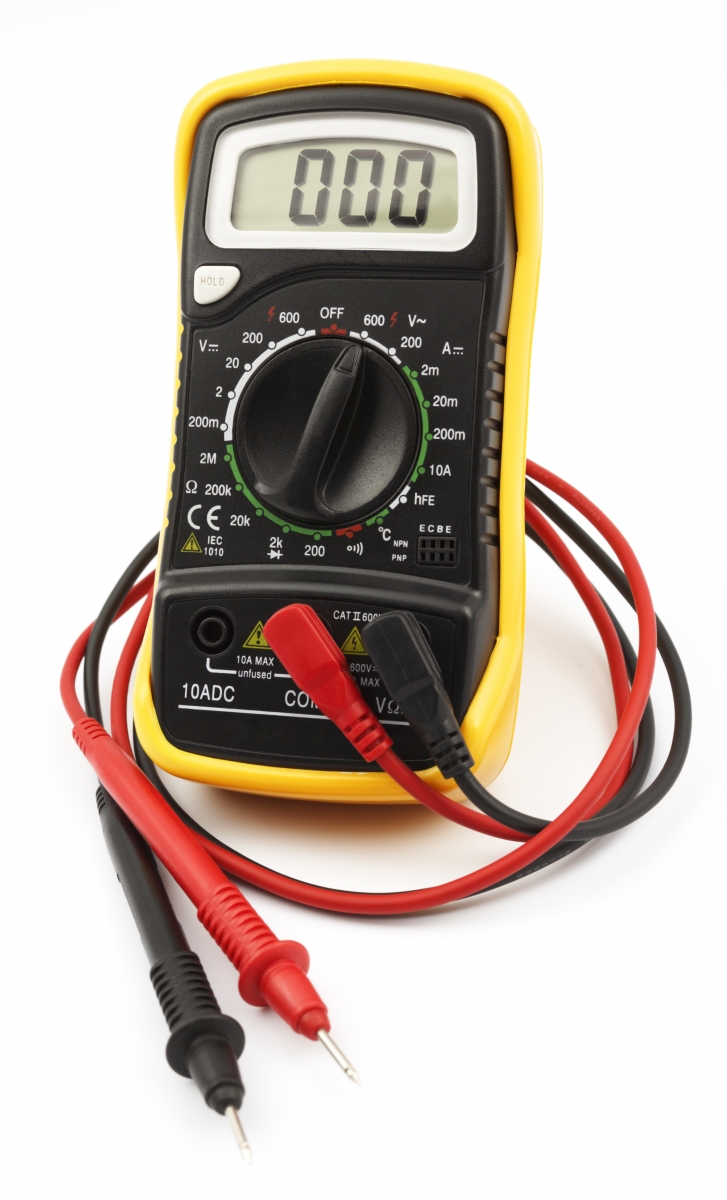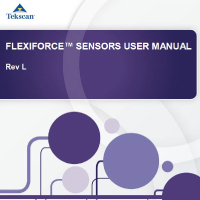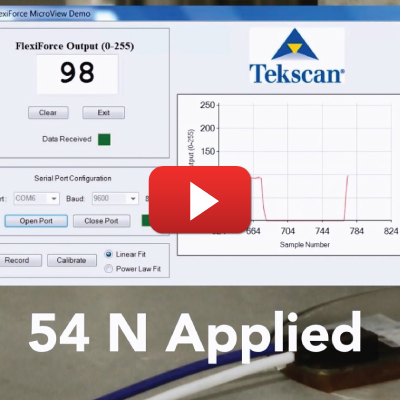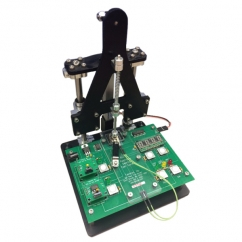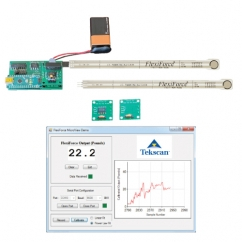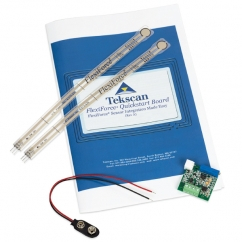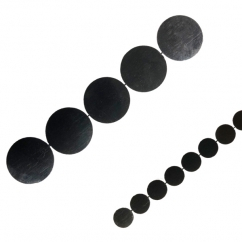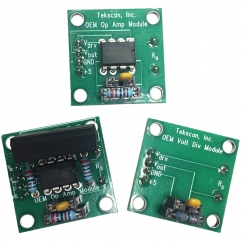Have questions? Contact Us
Description
FlexiForce™ A401 Sensor
The A401 has a 2-pin connector. This is our standard sensor with the largest sensing area: 25.4 mm (1 in.). A401 sensors are available in one force range: 111 N (0 - 25 lb).* The force ranges stated are approximations.
The dynamic range of this versatile force sensor can be modified by changing the drive voltage and adjusting the resistance of the feedback resistor (see "How to Adjust the Force Range" within the Electronics tab on the left).
Sensor output is a function of many variables, including interface materials. Therefore, Tekscan recommends the user calibrate each sensor for the application. The graph below is an illustration of how a sensor can be used to measure varying force ranges by changing the feedback resistor (the graph below should not be used as a calibration chart).
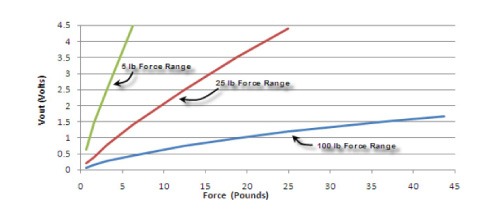
Specifications & Performance
| Sensor Thickness: | 0.203 mm (0.008 in.) |
| Force Sensor Length: | 56.9 mm |
| Sensing Size (Diameter/Width): | 25.4 mm |
| Standard Force: |
111 N |
| Temperature Range (Low): | -40 °C |
| Temperature Range (High): | 60 °C |
| Connector: | 2-pin Male Square Pin |
| Substrate: | Polyester |
| Pin Spacing: | 2.54 mm (0.1 in.) |
| Notes: | Tekscan's largest circular FlexiForce standard sensor. |
Typical Performance†
| Linearity (Error): | < ±3% of Full Scale (Line drawn from 0 to 50% load) |
| Repeatability: | < ±2.5% (Conditioned Sensor, 80% of Full Force Applied) |
| Hysteresis: | < 4.5 % of Full Scale (Conditioned Sensor, 80% of Full Force Applied) |
| Drift: | <5% / logarithmic time (Constant Load of 111 N (25 lb)) |
| Response Time: | < 5 µsec (Time required for the sensor to respond to an input force; Impact load - recorded on Oscilloscope) |
| Operating Temperature: | -40°C - 60°C (-40°F - 140°F) |
|
Durability: |
≥ 3 million actuations (Perpendicular load, room temperature, 22 N (5 lb)) |
|
Temperature Sensitivity: |
0.36%/°C (± 0.2%/°F) (Conductive heating) |
†All data above was collected utilizing an Op Amp Circuit. If your application cannot allow an Op Amp Circuit, consult the FlexiForce Integration Guide, or contact a FlexiForce Applications Engineer.
Electronics
Tekscan Recommends Using an Op Amp Circuit
If your application cannot allow an Op Amp Circuit, consult the FlexiForce Integration Guide, or contact a FlexiForce Applications Engineer. If you prefer to build your own electronics, we recommend using a circuit similar to the diagram below. This will provide linear data, making it easier to calibrate the sensor.
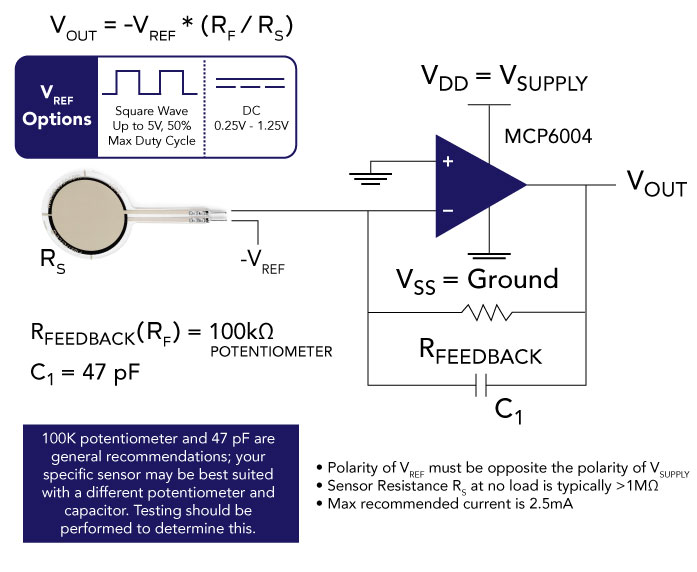
How to Adjust the Force Range:
*In order to measure higher forces, apply a lower drive voltage (-0.5 V, -0.25 V, etc.) and reduce the resistance of the feedback resistor (1kΩ min.) To measure lower forces, apply a higher drive voltage and increase the resistance of the feedback resistor.
Related Products
FlexiForce Sensor Characterization Kit
The FlexiForce™ Sensor Characterization Kit is a time-saving, affordable tool enabling engineers and designers to understand how FlexiForce sensors perform in a controlled loading environment.
FlexiForce Prototyping Kit
The FlexiForce™ Prototyping Kit allows you to efficiently progress your FlexiForce-embedded design through advanced integration phases.
Note: The FlexiForce Prototyping Kit includes an open-source software program designed specifically to help with the sensor integration process. Some code programming experience is necessary.
New and improved replacement for the OEM Development Kit.
Available direct from Tekscan or at Mouser.com.
FlexiForce Quickstart Board
The FlexiForce Quickstart Board is a finished single voltage source circuit which can be quickly dropped into a prototype or easily designed into a product to obtain force measurements. Available direct from Tekscan or at mouser.com.
FlexiForce Load Concentrators
Optimize FlexiForce sensor linearity and repeatability with these delrin load concentrators, or "pucks." Available direct from Tekscan (below) or at Digikey and Mouser.
FlexiForce Analog Circuit Modules
Interchangeable circuit modules for use with the FlexiForce Sensor Characterization Kit, the FlexiForce Prototyping Kit, or your own electronics.
